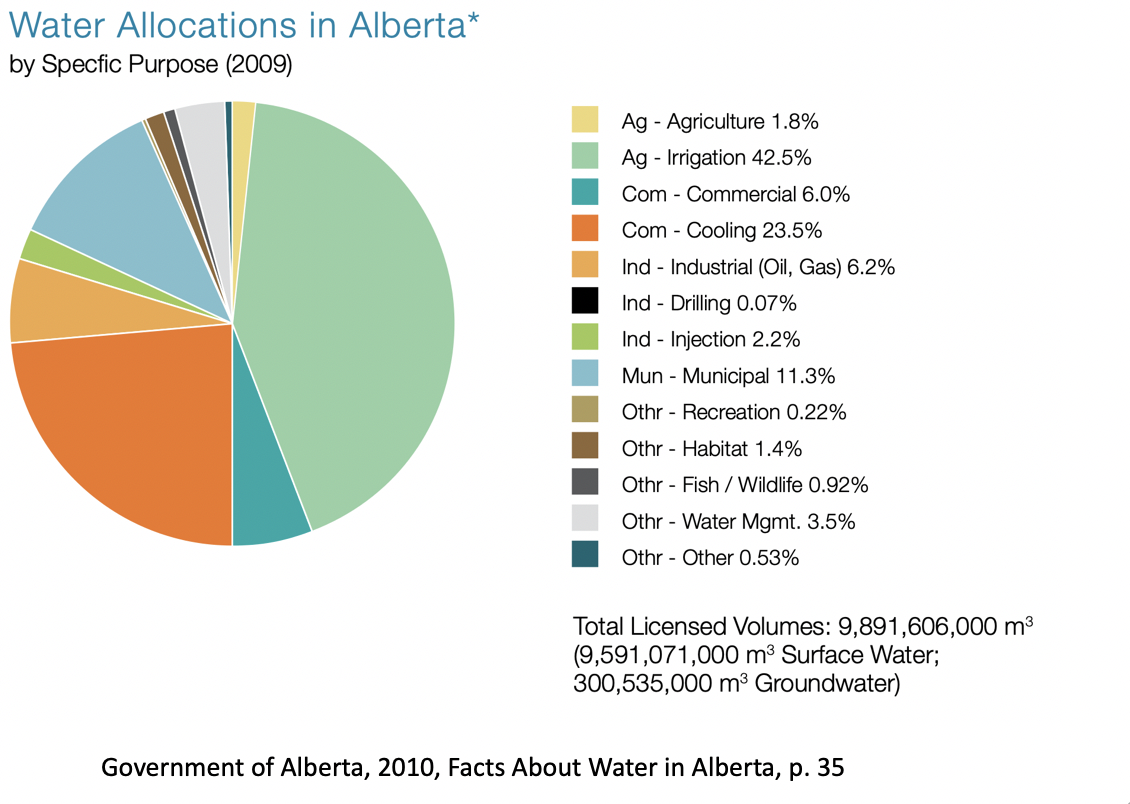Why Alberta Irrigation Matters
This page is no longer updated. Please visit this content on our new site, waterportal.ca for the most recent information.
With more irrigated agricultural land than the rest of Canada combined, Alberta is the ‘capital of irrigation’ in Canada. Irrigation provides agricultural producers with a supply of water to supplement natural precipitation through the growing season supporting consistent crop growth and yields.
Across Alberta’s more than 625,000 hectares of irrigated land, producers grow more than 60 different types of crops including 29 specialty crops, which allows them the flexibility needed to sustain viable farm enterprises, even with the market swings in commodity prices. That market flexibility does not come to the producer without a significant investment in irrigation equipment and other agricultural production systems, which in turn creates opportunities for businesses that support the producers. Sales of high-quality and dependable specialty crops and livestock support value-added food production in Alberta agri-food processing facilities. These facilities generate employment for many Albertans. Employment is also generated by businesses that sell inputs (seed, feed, fertilizer, machinery, and equipment, agronomic and financial services) to producers on irrigated land.
In Alberta, irrigation accounts for approximately 95 per cent of total water allocations within the agricultural sector. While it occurs on less than five per cent of the cultivated land base in the province, irrigation districts generated an average of approximately 28% of Alberta’s total agri-food GDP.
Click here to see a comprehensive economic analysis of the value of Alberta’s irrigation districts.
Where does irrigation water go?

In southern Alberta, irrigation districts primarily deliver water to agricultural producers to support crop and livestock production. However, the water delivery system also delivers water to other users and uses. About 50 municipalities and over 50,000 Alberta residents receive water for domestic use through the irrigation districts. Many businesses receive water through the delivery system to support their daily needs, and more than 33,000 hectares of wetland habitats are created or enhanced by water delivered through irrigation infrastructure.
Water to support irrigation districts is generally diverted from rivers. 9 irrigation districts rely on provincial government-owned diversion infrastructure; these are owned and operated by Alberta Environment and Parks. Two irrigation districts own and operate their own diversion infrastructure. In total, across all the districts, there are 41 off-stream reservoirs that are owned and operated by irrigation districts.
Reservoirs are a key part of the irrigation distribution system. They create resilience to flood and drought conditions by capturing water during high river flow and storing it for use. Water stored in reservoirs can also be released back into the system to protect aquatic life in rivers during low river flow events. Onstream reservoirs help the Province of Alberta meet water apportionment commitments to the downstream provinces of Saskatchewan and Manitoba. Irrigation storage reservoirs also support fish and waterfowl habitat, in addition to providing recreation opportunities. Reservoirs can even allow hydroelectric power generation in some cases.
Unfortunately, some water is lost from reservoirs to evaporation. Water is also lost to evaporation and seepage from irrigation canals. Investment in technological improvements and rehabilitation activities significantly reduce water loss and increase irrigation efficiency.
Current infrastructure and irrigation expansion projects
Most irrigation in Alberta occurs in the 11 irrigation districts located in southern Alberta although there are some private irrigators that operate in the province. Within the districts, irrigated farmland covers approximately 560,000 hectares of land. The water distribution network supporting irrigation districts is extensive consisting of:
- 8,000 kilometres of conveyance pipelines and canals,
- 52 irrigation storage reservoirs, and
- 4,900 kilometres of drainage canals returning surplus water to source rivers.
In the fall of 2020-2021, a historic modernization program was announced by the Government of Canada, the Province of Alberta, and 9 irrigation districts*. The program enables a financial investment of $932.7 million funded by the districts, the Government of Alberta, and the Government of Canada through the Canada Infrastructure Bank to support infrastructure rehabilitation projects and the construction or enlargement of up to four off-stream irrigation storage reservoirs. Modernization projects that are eligible for this program will have numerous benefits including water use efficiency improvements through reduction of evaporation, seepage, and spills. Increased water use efficiency will improve water security and mitigate increasing variability in the water supply as a result of climate change. Improved water security could lead to irrigation expansion, subject to approval by current irrigators within the districts, which will benefit the economy. See the chart below for the program funding details:
| 30% | The Government of Alberta |
| 50% | The Government of Canada through the Canada Infrastructure Bank (CIB) through a long-term financing arrangement |
| 20% | Involved districts** |
*Effective April 21st, 2023, the Taber Irrigation District amalgamated with the St. Mary River Irrigation District. All former Taber Irrigation District projects are now listed on the St. Mary River Irrigation District page. Effective April 1st, 2023, the Aetna and Leavitt districts merged to become the Southwest Irrigation District. All former Leavitt Irrigation District information can be found on the Southwest Irrigation District page.
**In addition to providing 20 per cent up-front costs, districts are fully responsible for the repayment of the financing provided by the CIB (50%).
Click on the links below to learn more about the individual projects funded through this investment in the Alberta Irrigation Districts:
- Bow River Irrigation District
- Eastern Irrigation District
- Lethbridge Northern Irrigation District
- Raymond Irrigation District
- Ross Creek Irrigation District
- Southwest Irrigation District
- St. Mary River Irrigation District
- United Irrigation District
- Western Irrigation District
Map of Irrigation Infrastructure Projects
The following map shows the location of the modernization projects of the irrigation districts in Alberta.
Zoom in to see a sketch of the projects. For further information and more detailed drawings of the projects see the individual irrigation district pages.
Frequently Asked Questions
To learn more about the modernization plans, click here for a list of frequently asked questions.

